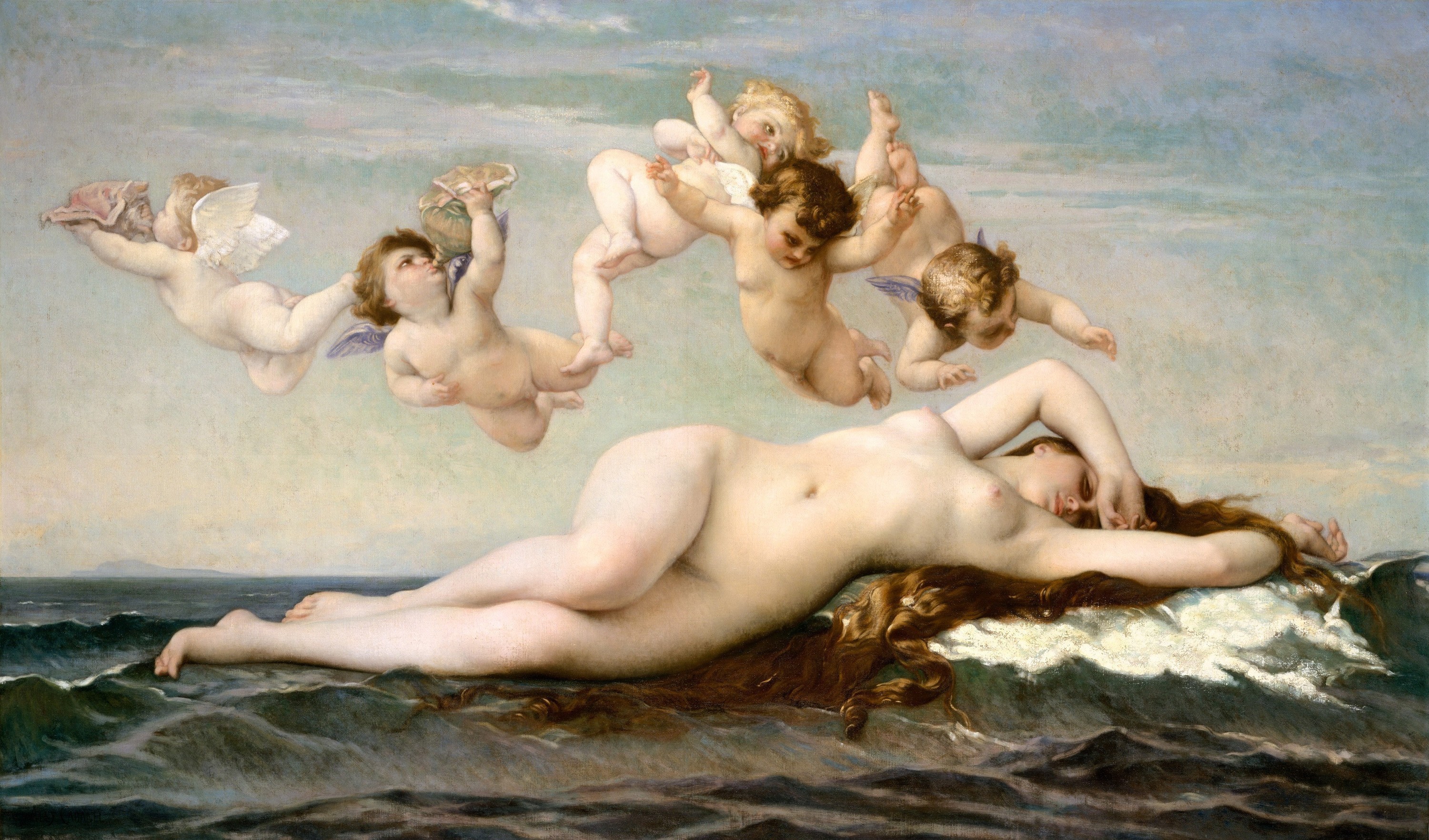In Greek Mythology, the character of Aphrodite, the Greek goddess of love and beauty, stands out as a fascinating figure. She's a symbol of physical attractiveness and romance, representing the complexities and intrigue of Greek mythology.
Let's discover more about Aphrodite, exploring her origins, powers, and the stories that make her one of the most captivating figures in ancient mythology.
Jump to:
Who Was Aphrodite?

Aphrodite is widely recognised as the Greek goddess of love, beauty, and eternal youth. She embodies the allure and charisma that draws others towards her. This magnetic charm also reflects her influence over love and relationships. She's a central figure in Greek mythology, influencing the lives of gods and mortals.
What is Aphrodite Known For?
Aphrodite is most famous for being the goddess of love, beauty, and eternal youth. Her roles in various myths, such as the Judgement of Paris and the Trojan War, highlight her significant impact on Greek mythology.
The Origins of Aphrodite
One of the most intriguing aspects of Aphrodite is her mysterious origin. According to one popular myth, she was born from the sea foam, arising from the waters on a shell, a vision of beauty and grace. This birth story links her to the elemental force of nature, suggesting her power is as vast and deep as the ocean itself.
Aphrodite's Powers and Influence
Aphrodite possesses remarkable powers, primarily her ability to invoke love and desire among gods and humans. Her influence extends to sparking passion, resolving conflicts, and even starting wars, as seen in the famous tale of the Trojan War. Her powers remind us of the immense impact that love and attraction have in myth and reality.
Myths and Legends: The Aphrodite Story
Aphrodite's story is woven through many myths, each revealing different elements of her personality and powers. These tales often showcase her interactions with other gods, her involvement in mortal affairs, and the consequences of her actions.
The Famous Myths of Aphrodite
The Judgement of Paris: One of Aphrodite's most significant roles is in the Judgement of Paris, a story that sparked the legendary Trojan War. This tale begins with a dispute among the goddesses over who was the fairest.
Paris, a mortal prince of Troy, was chosen to decide. Aphrodite, Hera, and Athena each offered him a tempting bribe. Aphrodite's promise to Paris – the love of Helen, the most beautiful woman in the world – won his favour. However, Helen was already married to King Menelaus of Sparta, and her abduction by Paris led to the ten-year Trojan War, a central event in Greek mythology.
The Love Triangle of Ares, Hephaestus, and Aphrodite: Aphrodite's marriage to Hephaestus, the god of craftsmanship, was marked by her affair with Ares, the god of war. This love triangle is a classic example of the complexities of relationships among the gods.
Hephaestus, learning of the affair, crafted a net to trap the lovers in the act, exposing them to the ridicule of the other gods. This story highlights the intertwining themes of love, betrayal, and humiliation.
Pygmalion and Galatea: One of the most heartwarming tales involving Aphrodite is the story of Pygmalion and Galatea. Pygmalion, a sculptor, disenchanted with real women, sculpted Galatea, a statue so perfect and beautiful that he fell in love with her.
Moved by his devotion, Aphrodite brought Galatea to life, and Pygmalion's love was reciprocated. This myth highlights Aphrodite's power to reward true devotion and transform the inanimate into the living, embodying the transformative nature of love.
Anchises and the Birth of Aeneas: Another significant legend involves Aphrodite and Anchises, a mortal. Aphrodite, often the instigator of love, fell for the handsome Anchises.
Their union led to the birth of Aeneas, a hero of the Trojan War and later, according to Roman mythology, an ancestor of Romulus and Remus, the founders of Rome. This myth connects Aphrodite to the Roman epic narrative and highlights her role in shaping the destinies of heroes and nations.
The Curse of Hippolytus: A less-told but impactful story is the curse of Hippolytus. Hippolytus, a devotee of Artemis, scorned the worship of Aphrodite, which angered the goddess. In revenge, Aphrodite caused his stepmother, Phaedra, to fall hopelessly in love with him.
When Hippolytus rejected her advances, Phaedra, in despair, accused him of assaulting her, leading to his death. This tragic tale showcases the darker aspects of Aphrodite's power – her ability to manipulate emotions and the devastating consequences of her wrath.
Aphrodite's Relationships and Children
The Romance with Adonis: Among her many affairs, Aphrodite's relationship with Adonis stands out. Adonis, a mortal of unparalleled beauty, caught the eye of Aphrodite. This relationship, marked by passion and tragedy, ended with Adonis's untimely death, a loss that deeply affected Aphrodite. The story of Adonis represents the fleeting nature of beauty and the pain of loss.
Eros (Cupid) – The Symbol of Love: Aphrodite's son Eros, also known as Cupid, is a powerful symbol of love. Born from her union with Ares, Eros is often depicted as a mischievous child with a bow and arrow, causing both gods and mortals to fall in love.
The stories of Eros complement the narrative of Aphrodite, reinforcing the themes of love, desire, and the interconnectedness of relationships.
The Dark Side of Aphrodite
Jealousy and Vengeance: While often celebrated for her beauty and role in fostering love, Aphrodite's darker aspects are equally significant.
Her jealousy and vengefulness were particularly evident in her interactions with women who challenged her status as the most beautiful. For example, Psyche, a mortal woman, was subjected to Aphrodite's wrath due to her beauty, leading to a series of trials and tribulations.
The Curse of Aphrodite: Aphrodite's ability to curse those who offended her is well-documented in myths.
One notable instance is the curse she placed on the women of Lemnos, causing them to emit a foul smell and leading to their abandonment by their husbands. This story reflects the harsh consequences of invoking Aphrodite's anger and the power she wielded.
Who Are Aphrodite's Children?

Aphrodite is known for her numerous offspring. Each of her children, born from different unions, represents various facets of love and attraction, furthering her influence in the mythical world.
- Eros (Cupid): The Embodiment of Romantic Love. Eros, known as Cupid in Roman mythology, is perhaps the most famous of Aphrodite's children. Often depicted as a cherubic figure with a bow and arrows, Eros has the power to make anyone fall in love. He is a frequent presence in mythology, causing many love stories and entanglements among gods and mortals.
- Anteros: The Avenger of Unrequited Love. Anteros, often considered a brother or counterpart to Eros, is the god who avenges unrequited love. He is sometimes portrayed as punishing those who scorn love or do not return the affections of others. Anteros symbolises the complexities in relationships.
- Himeros: The Personification of Desire. Himeros represents unrequited love and longing. His presence in mythology underscores the theme of desire that often accompanies love, enhancing the emotional depth of various tales involving his mother.
- Pothos: The God of Passionate Longing. Pothos is associated with yearning and longing, especially for someone absent. This deity encapsulates the pain and ache of separation, reflecting love's deeper, more sorrowful aspects.
- Harmonia: The Embodiment of Harmony and Concord. Harmonia, born from Aphrodite's affair with Ares, is the goddess of harmony and concord. She symbolises the peaceful and uniting aspects of relationships, often seen as the counterbalance to the strife and discord sown by her father, Ares.
- The Graces (Charites): Representations of Beauty and Charm. The Graces, often counted among Aphrodite's children, are goddesses who represent beauty, charm, and grace. They are typically depicted as three sisters who bestow beauty and joy upon both gods and humans, enhancing the creative and pleasant aspects of existence.
- Priapus: The God of Fertility and Lust. Priapus, a god associated with fertility and lust, is another of Aphrodite's children. His representations often focus on the physical and less spiritual aspects of love, showcasing the diverse spectrum of Aphrodite's influence over human emotions and relationships.
- Deimos and Phobos: Personifications of Fear and Terror. Born from her union with Ares, Deimos (dread) and Phobos (fear) are less associated with the themes of love and beauty and more with the consequences of war and conflict. Their existence underscores the complex relationship between love and strife.
- Rhodos and Herophile: Lesser-Known Offspring. Rhodos, a sea nymph, and Herophile, a Sibyl (prophetess), are also considered among Aphrodite's children. They represent the far-reaching influence of Aphrodite in the mythological world.
The Symbolism and Legacy of Aphrodite

Aphrodite's influence extends far beyond the ancient world. She represents physical beauty, the power of attraction, and the complexity of human emotions. Her symbolism is evident in art, literature, and culture, making her an enduring figure in the collective imagination.
Aphrodite in Art and Sculpture
Timeless Beauty in Sculpture: The image of Aphrodite has been immortalised in countless artworks, particularly in sculpture. The Venus de Milo, a celebrated statue, is a pinnacle of her representation.
This ancient Greek statue dates back to between 130 and 100 BCE and is renowned for its missing arms and mysterious beauty. It captures Aphrodite's elegance and grace, embodying the classical ideals of feminine beauty. The statue's lasting fame underscores the enduring fascination with Aphrodite as a symbol of aesthetic and romantic ideals.
Aphrodite in Renaissance Art: Aphrodite's image experienced a revival during the Renaissance. In his famous work 'The Birth of Venus', artists like Botticelli reimagined her birth from the sea, highlighting her as a symbol of beauty and the humanistic revival of classical ideals.
These artworks depict her physical beauty and convey her role as a muse, inspiring artists and poets through the ages.
The Roman Name and Counterpart of Aphrodite
In Roman mythology, Aphrodite is known as Venus. While there are subtle differences in how the Romans interpreted her stories and characteristics, the core attributes of love, beauty, and fertility remain consistent.
Venus played a similarly central role in Roman mythology and was known as an ancestral figure by the Romans, notably in the myth of Aeneas, the founder of Rome.
The Meaning and Pronunciation of Aphrodite
The name Aphrodite itself suggests her character, often linked to the Greek word 'aphros', meaning foam, in reference to her birth from the sea foam. Her name is pronounced as [af-roh-dye-tee], capturing the lyrical quality of ancient Greek.
The Symbol of Aphrodite
Aphrodite's association with symbols like the dove, rose, and myrtle has deep roots in her mythological narrative.
The dove, often seen in depictions of the goddess, symbolises peace and love. The rose, with its beauty and thorns, represents the dual nature of love - its capacity to bring joy and pain. The myrtle, a plant associated with weddings and love in ancient Greece, signifies Aphrodite's role in romance and marriage.
These symbols have transcended their mythological origins, becoming universal emblems of love and beauty in various cultures.
Frequently Asked Questions About Aphrodite
Why is Aphrodite Considered a Complex Goddess?
While Aphrodite is celebrated for her beauty and power in love, she also has a darker side, characterised by jealousy and vengeance. This complexity makes her a multifaceted figure, representing the broad spectrum of human emotions.
Did Aphrodite Have a Roman Counterpart?
Aphrodite's Roman counterpart is Venus. While there are some differences in their stories and attributes, the essence of the goddess as a symbol of love and beauty remains consistent in Roman mythology.
What is the Famous Statue of Aphrodite?
The Venus de Milo is one of the most famous statues of Aphrodite. It dates back to ancient Greece and is celebrated for representing classical beauty and grace.
How Do You Pronounce Aphrodite?
The name Aphrodite is pronounced as [af-roh-dye-tee], reflecting the melodic nature of the ancient Greek language.
Was Aphrodite Always Portrayed Positively in Myths?
Aphrodite had a complex personality in myths. She was capable of deep love and kindness but also of jealousy and revenge when provoked or offended.
What is Aphrodite's Role in the Trojan War?
In the Trojan War, Aphrodite promised Paris, the Trojan prince, the love of Helen, the most beautiful woman in the world. This promise led to Helen's abduction and the subsequent war between Troy and the Greek forces.
Who is Aphrodite's Biggest Enemy?
Aphrodite's most notable enemy is Hera, the queen of the gods. Their rivalry is often referred to in various myths, particularly in stories in direct conflict, such as the Judgement of Paris.
Does Aphrodite Have a Dark Side?
Aphrodite does have a darker aspect. She can be vengeful and manipulative, particularly in stories where her beauty or domain of love and relationships is challenged or scorned.
Who Was Aphrodite's Favourite Lover?
Among her many lovers, Ares, the god of war, is often considered Aphrodite's favourite. Their passionate and tumultuous relationship is a recurring theme in Greek mythology.
Why Did Zeus Punish Aphrodite?
In some myths, Zeus punished Aphrodite to remind her of her place and to temper her manipulative tendencies, especially when her actions threatened the balance among the gods or influenced major events like the Trojan War.
Is Aphrodite Older Than Zeus?
Aphrodite is not older than Zeus. According to most myths, Zeus is one of the earlier gods of the Greek pantheon, while Aphrodite's origins vary, with some tales suggesting she emerged later.
What is Aphrodite's Weakness?
Aphrodite's primary weakness is her susceptibility to human emotions like jealousy, pride, and vengefulness, which often lead her into complicated situations and conflicts.
What Was Aphrodite's Hair Colour?
Aphrodite is often depicted with golden or light hair, symbolising her beauty and divine nature. However, representations can vary, with some artworks showing her with darker hair.
Where Can I Find Sculptures of Aphrodite?
Sculptures of Aphrodite can be found in various museums worldwide, with the Venus de Milo in the Louvre Museum in Paris being one of the most famous examples.
How Can I Learn More About Aphrodite and Greek Mythology?
Centre of Excellence offers a comprehensive Greek Mythology Diploma Course for those interested in exploring the captivating world of Greek mythology and the tales of Aphrodite. This course provides in-depth knowledge and understanding of the rich tapestry of Greek myths and legends.
Recommended for you!
Best SellersDiscover the Wonders of Ancient Myths with Our Greek Mythology Diploma Course
Unveil the mysteries of Greek mythology and immerse yourself in the captivating stories of deities, heroes, and legendary tales with our Greek Mythology Diploma Course.
What You'll Explore
- Rich Mythological Lore: Delve into the depths of ancient Greek mythology, uncovering the intricate narratives and characters that have inspired generations.
- Understanding Deities and Heroes: Gain insights into the lives and adventures of prominent figures like Aphrodite, Zeus, Hercules, and many more, understanding their roles and influences in mythological stories.
- Cultural and Historical Contexts: Explore the historical and cultural significance of these myths, uncovering how they reflect ancient Greek values and continue to influence modern society.
Special Offer
In our mission to promote transformative and accessible education, we're excited to present this comprehensive Greek Mythology Diploma Course for just £29.













